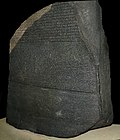The Rosetta Stone is a large black stone stele bearing a translation of Ancient Egyptian text, the first recovered in modern times. Found in 1799, it is inscribed with three versions of a decree from 196 BC announcing the rule of King Ptolemy V. The texts are in Ancient Egyptian using hieroglyphic script and Demotic script and in Ancient Greek. The stone proved to be the key to deciphering Egyptian hieroglyphs. It was taken from building material in Fort Julien near the town of Rashid (Rosetta) in the Nile Delta when it was rediscovered during the Napoleonic campaign in Egypt. After British troops defeated the French in Egypt in 1801, they seized the stone and transported it to London. It has been on public display at the British Museum since 1802, and is the museum's most-visited object. Since its rediscovery, the stone has been the focus of nationalist rivalries, including a long-running dispute over the relative value of Thomas Young's and Jean-François Champollion's contributions to the decipherment, and demands this century for the stone's return to Egypt. (Full article...)
